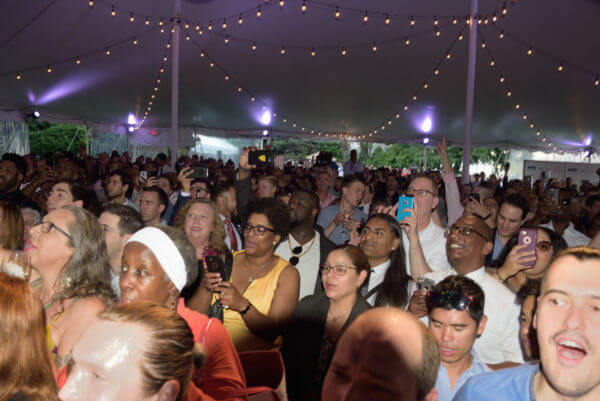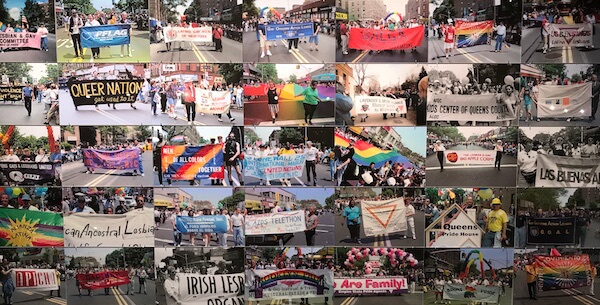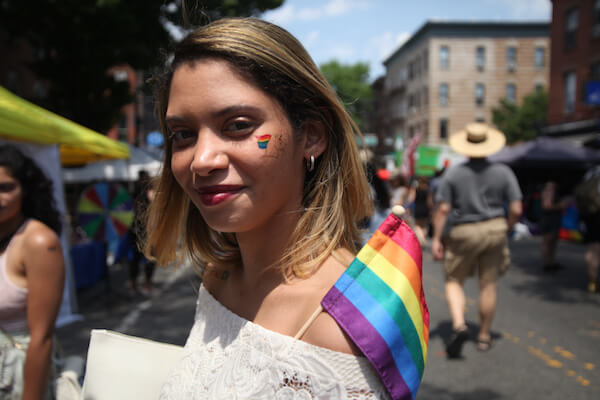First Lady Chirlane McCray with youth affiliated with HMI, including (to her immediate right) Sophie Cadle and (to her left, in a black sweatshirt with a red map of Africa) Blake Brown. | DONNA ACETO
Blake Brown is a 20-year-old who grew up in the South Bronx, where as a young teen, she acknowledges, she was something of a “poster child” when her high school’s administrators tried to make the case that the school sorely lacked needed resources.
That experience was searingly painful for her. As a child she endured sexual assault, and by middle school she would often cry and cut herself, as well as experience suicidal and homicidal ideation.
“I felt nothing but worthlessness and ended up in the hospital,” she told Gay City News early this month at the Hetrick-Martin Institute (HMI), at Astor Place in the East Village, where she spent her junior and senior year at the Harvey Milk High School.
The change in Brown when she arrived at Harvey Milk was dramatic and almost immediate.
“I was bugging out with good grades,” she said, “going out in the world and letting them know it gets better.”
Chirlane McCray’s visit to Astor Place highlights new model for addressing mental health needs
One of her proudest moments came when she traveled to the White House for the ceremony where President Barack Obama dedicated the Harvey Milk postage stamp.
An aspiring R&B and hip hop vocalist — she’s won three championships in music venues around town — Brown is also an HMI peer educator, engaging other youth at middle schools, high schools, and events like Queens and Brooklyn Pride.
“I am very comfortable giving them the directive to come here,” she said of the advice she offers LGBTQ youth she meets in her outreach. “You have to be comfortable in sharing your story.”
Sophie Cadle, 22, is also an HMI success story. Six years ago, she explained, she was living as an effeminate teenage boy with her bipolar grandmother. In January 2015, she “hit rock bottom,” street homeless and engaging in survival sex work and burglary. The theft landed her in Rikers Island and also the psych ward at Bellevue, where she was on suicide watch.
Anti-depressants and abstinence from recreational drugs helped stabilize Cadle, and at Rikers she met trans women “and I grabbed their stories.” She recognized she did not want to endure a life in the prison system, but she also acknowledged her need to transition to living as a woman.
“I never thought of transitioning before jail,” Cadle explained, “but then I wanted to create a whole new person.”
Of what she has gained over the past two years, she said, “I am now secure, confident, and empowering my peers. I want to work in trans youth advocacy, perhaps with an employment program.”
Both Brown and Cadle are keenly aware, however, that the gains they’ve made are tough for many other LGBTQ youth to achieve. That’s what motivates the peer education work both do. It also prompted Cadle to voice her concerns about her transgender sisters and brothers to Chirlane McCray, when the city’s first lady visited HMI on June 6.
There are simply not enough mental health services for transgender youth in New York, Cadle told McCray, a message about which the first lady was already under no illusions.
Chirlane McCray meeting with staff of the Hetrick-Martin Institute. | DONNA ACETO
“There’s no way any time soon we will have enough mental health professionals, especially for LGBTQ youth from communities of color,” McCray responded to a group of HMI staff and young people affiliated with the agency.
In fact, the first lady was visiting HMI as part of the city’s Connections to Care (C2C) program, currently a $30 million public-private partnership that is evaluating the integration of mental health support at community-based organizations (CBOs) serving low-income and other at-risk populations. HMI is one of 15 CBOs citywide where C2C is underway, with the goal of empowering their mental health professionals to share their expertise with other staff. The ultimate goal is enabling organizations like HMI to better identify the mental health needs of its clients and “connect” them to appropriate care.
According to Darren Bloch, executive director of the Mayor’s Fund to Advance New York City, which oversees the C2C program along with 53 other efforts under the “ThriveNYC: A Mental Health Roadmap for All” umbrella, one in five New Yorkers is dealing with a mental health issue. A large number of those people go untreated, many of them unaware they face a specific — and treatable — problem at all.
Bloch joined McCray on her visit to HMI, and he explained that the C2C program is based on “a model that already had some promising evidence behind it.”
The goal in visiting HMI and in the overall evaluation of the C2C effort was, McCray explained, “really to see how it’s going. See how it’s working. It’s that simple.”
The city, she said, spent 11 months visiting CBOs all over New York, in diverse settings, before launching ThriveNYC and its C2C component last year.
“Nobody’s really taken mental health and tried to think through how we deliver comprehensive services to everybody no matter where they live, where they learn, where they study in a way without stigma and in a way that is truly accessible,” McCray explained. “So we have these 54 programs.”
Thomas Krever, the CEO of HMI, offered perspective on how the C2C program is strengthening his organization. HMI educates 80 students at the Harvey Milk High School and serves roughly 2,500 youth in a wide array of counseling, health and wellness, educational enrichment, and arts, culture, and recreation programs. Its street outreach efforts engage another 11,000 youth each year.
Nearly all of the youth who access the HMI facilities come from communities of color, with an estimated 80 percent from low-income families. Challenges facing these young people run the gamut from housing insecurity to families who don’t accept their sexual orientation or gender identity.
“The needs are exorbitant,” Krever said.
Thomas Krever, CEO of the Hetrick-Martin Institute. | DONNA ACETO
Any youth arriving at HMI gets a mental health assessment, and in fact more than 40 percent, or about 1,100, are referred for long term counseling programs. But Krever and his staff are well aware that deep-seated issues may not present during an initial assessment. A big part of that has to do with building trust, something McCray acknowledged in her comments to Gay City News.
“How could they possibly have the capacity to trust when they’ve been treated in such a harsh way in their lives?,” she said.
Krever’s organization has always worked hard to keep an institutional eye out for hidden challenges holding its youth back, but it’s a tall order. HMI has a Clinical & Counseling staff of six, including a psychiatrist. Many other staff members across the spectrum of services have social work and health care backgrounds that have trained them to be attuned to their clients’ needs. Lillian Rivera, as director of advocacy and capacity building, takes overall responsibility for keeping staff trained and informed about the strengths different departments bring to the table.
What the C2C program aims to add to this is expertise on making skills transferrable across the organization, which has a staff of 90, to develop “a common language” that can inform all of HMI’s work.
According to Bridget Hughes, the group’s director of Youth Services, that perspective reflects “a cultural shift. While we codify our practices, we are working to infuse all our after-school programs with a mental health awareness.”
HMI now has monthly professional development trainings, which build skills, but also, Hughes emphasized, “relationships.”
From Krever’s vantage point, the effort amounts to “codifying 40 years of our work” in a youth setting that is “not your average swim and gym.”
What Krever and Hughes said about the C2C initiative squares neatly with the perspective of McCray and Bloch.
“We’re training the people who are already doing this work,” McCray said of the 15 CBOs in the C2C program. “They’re already doing it, whether they’re social workers, whatever their title is. They are providing services to communities like this one, they’re just not necessarily trained, there’s no common language.”
Asked if the effort is all about leveraging resources, the first lady responded, “Well, we call it task-shifting. We’re leveraging, again, people who are already doing the work and giving them additional training and giving them support from professionals so that they can do their work better.”
Both McCray and Bloch came away from HMI impressed with what they saw. Saying he’s visited many CBOs around the city, Bloch called the afternoon at Astor Place “inspiring.”
Discussing the awareness and fluency she witnessed among the HMI youth regarding both mental health issues and self-empowerment, McCray said, “It’s so encouraging” given the “depression and rage” experienced by young people, “especially those living on the margins.”
Over the next two years, the city will complete an evaluation of the 15 CBOs currently engaged in the C2C program.
“We want to go to scale,” McCray explained. “We’d love to bring this model to more CBOs around the city because the need is so great. We just want to make sure that it works.”





































